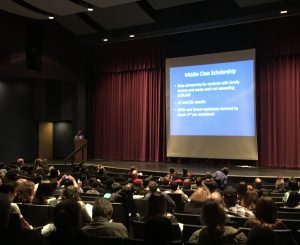The Face of Financial Aid

On the night of Wednesday October 12, Financial Aid Night took place in the Wilcox Theater. Financial aid booklets were handed out in the foyer before the beginning of the speech, which was given by Coleetta McElroy, the San Jose State University Director of finances and scholarships, as well as the staff of the university. Her speech included basic information on Free Application for Federal Student Aid (FAFSA), the types of Federal Aid, and how much aid a student receives.
Simply put, financial aid is any money-related type of assistance that helps students pay certain expenses for things like college, such as scholarships and grants. Students can receive a certain amount of aid from the Federal Government if they fill out the FAFSA. The FAFSA is an application for financial aid that can be found on the FAFSA government website. Information such as student demographics, financial information (for students and parents), dependency status, parent demographics, household information, and school selection must be included in the application.
However, within this process lies certain pitfalls that many applicants struggle with. One of these is the parental information. This part of the application is deliberately left out because many applicants think that it is extraneous. However, the information is necessary. This part of the application plays a pivotal role in determining if you are qualified to receive financial aid.
Another major pitfall is the actual applying part itself. Many students will either sign up last-minute or not even sign up at all. As a result, many students miss out on financial aid. Signing up early also has one major advantage. Mrs. McElroy states, “To qualify for maximum funding, students should apply early and meet all deadlines established at the college. Also, look at applying for all scholarships to provide additional assistance that would lower or remove the need to apply for loans.”
There are many ways a student can receive aid. Grants, loans, work-study jobs, and scholarships are all options students can apply for. Work-study jobs, which are part-time jobs undergraduate and graduate students can partake in, are options that are need-based. These part-time jobs encourage service to the community, and others can assist you in your course of study. The aid can be earned on or off campus, and payment is at least minimum wage.
Loans are another part of the financial aid package. There are two types of loans: federal and private. Federal loans offer many more advantages than private loans. One advantage is that federal loans have cheaper and more fixed interest rates than a regular, private loan. Also, Federal loans grant certain bonuses that private loaners do not. Federal loans offer options to postpone payments under certain conditions. Federal loans also limit your monthly payments.
Another great method of earning aid is through scholarships. A scholarship is a type of financial aid that can be earned through merit, background, or financial need. Scholarship aid amounts can vary: some can cover a large amount of a student’s living expenses or tuition, or less than a thousand dollars. However, applying for scholarships is still beneficial. Scholarship applications can “provide additional assistance that would lower or remove the need to apply for loans,” explains Mrs. McElroy.
How much need-based aid can a student receive? It goes along the lines of this: the Cost of Attendance (COA) minus the Expected Family Contribution (EFC) equals financial need. Basically, the COA is the amount of money that colleges charge their students for the whole college experience. Areas such as room and board, tuition and fees, books, transportation, and so on make up the Cost of Attendance. The EFC is a number that is calculated with factors such as family taxed and untaxed income, family size, and assets taken into consideration. However, if the financial need is not a high enough number, you will not be considered as eligible for need-based financial aid. Fortunately, non- need based financial aid can be earned. Non-need-based aid is aid that is earned without the EFC. It is calculated by subtracting financial aid that is already awarded from the COA.
Whether you are a senior or freshmen, it is never too early to plan for your future. It is not about finances only. Although financial aid certainly benefits you, it will not assist you in areas like getting good grades, making the right choices, and honing valuable skills. All of these factors are not dependent on things like FAFSA or the COA, but are completely on you.
